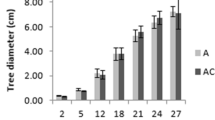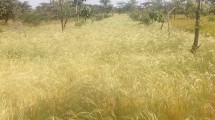Abstract
Three trials investigating the potential of alley cropping to improve the traditional systems of cultivation, chitemene and fundikila, in the Northern Province of Zambia are described. Flemingia congesta, Tephrosia vogelii, and Sesbania sesban, were grown in association with finger millet, groundnut, cowpea, and maize in various traditional cropping sequences. The indigenous species Tephrosia vogelii and Sesbania sesban were not able to withstand repeated pruning and the long following dry season, and were replaced with Calliandra calothyrsus, and Cassia spectabilis.
Over a four year period, there was no benefit by alley cropping with any of the tree species on crop yields, and yields in alley crop treatments even dropped significantly below the control treatments in the fourth year, casting doubt on the potential of alley cropping for sustainable production. There was also no consistent effect on soil chemical characteristics in any of the trials. It was suggested that this lack of beneficial response to alley cropping was due to low tree biomass production low quality of prunings, and an inappropriate cropping sequence. There was no evidence that alley cropping contributed to enhanced nutrient recycling, despite substantial localised pools of soil nutrients, particularly in the chitemene, with which recycling could potentially occur.
Similar content being viewed by others
References
AFRENA (1989) In: Kwesiga F and Kamau IN, eds, Agroforestry Potential in the Unimodal Upland Plateau of Zambia. Agroforestry Research Network for Africa (AFRENA), Report No. 7. ICRAF, Nairobi
Budelman A (1988a) The decomposition of the leaf mulches of Leucaena leucocephala, Gliricidia sepium and Flemingia macrophylla under humid tropical conditions. Agroforestry Systems 7: 33–45
Budelman A (1988b) Leaf dry matter productivity of three selected perennial leguminous species in humid tropical Ivory Coast. Agroforestry Systems 7: 47–62
Chidumayo EN (1987) A shifting cultivation land use system under population pressure in Zambia. Agroforestry Systems 5: 15–25
Davies BE (1971) A statistical comparison of pH values of some English soils after measurement in both water and 0.01 M CaCl2. Proc Soil Sci Soc Am 35: 351–552
Huxley PA, Rocheleau DE and Wood P (1986) Farm systems and agroforestry research in north Zambia: Phase I report — Diagnosis of land-use problems and research indications. ICRAF, Nairobi, Kenya
John MK (1979) Colorimetric determination of phosphorus in soil and plant materials with ascorbic acid. Soil Sci 109: 214–220
Kang BT, Grimme H and Lawson TL (1985) Alley cropping sequentially cropped maize and cowpea with Leucaena on a sandy soil in southern Nigeria. Plant and Soil 85: 267–276
Kang BT and Wilson GF (1987) The development of alley cropping as a promising agroforestry technology. In: Steppler HA and Nair PKR, eds, Agroforestry — A Decade of Development. ICRAF, pp 227–243
Kessler JJ and Breman H (1991) The potential of agroforestry to increase primary production in the Sahelian and Sudanian zones of West Africa. Agroforestry Systems 13: 41–62
Kirk PL (1960) Kjeldahl method for total nitrogen. Annals of Chemistry 22: 354–358
Lal R (1989a) Agroforestry systems and soil surface management of a tropical alfisol. III. Changes in soil chemical properties. Agroforestry Systems 8: 113–132
Lal R (1989b) Potential of agroforestry as a sustainable alternative to shifting cultivation: concluding remarks. Agroforestry Systems 8: 239–242
LIMA (1991) Lima crop recommendations, Northern Province: small scale farmer recommendations (ed. Uprichard T). Ministry of Agriculture, Zambia
Mansfield JE (1973) Summary of agronomic rindings in Northern Province, Zambia. Supplementary Report 7, Land Resources Division, Ministry of Overseas Development, England
Mansfield JE, Bennet JG, King RB, Lang DM and Lawton RM (1975) Land resources of Northern and Luapula Provinces, Zambia. In: Land Resource Study 19, Land Resources Division, Ministry of Overseas Development, England
Matthews RB, Lungu S, Volk J, Holden ST and Solberg K (1992) The potential of alley cropping in improvement of cultivation systems in the high rainfall areas of Zambia. II. Maize production. Agroforestry Systems (this issue)
Mattsson LE (1989) Agroforestry diagnosis in Mambwe area Northern Province of Zambia: assessment of constraints and potentials to agriculture production systems in Nsokolo watershed with targets for agroforestry research and development. Ph.D. Thesis, Agricultural University of Norway, Ås, Norway
McLean EO (1965) Aluminium. In: Black CA, ed, Methods of Soil Analysis. No. 9 in the Series Agronomy. American Society of Agronomy and Soil Science, America. Madison, Wisconsin, pp 986–994
O'Sullivan TE (1985) Farming systems and soil management: the Philippines/Australian Development Assistance Program experience. In: Crasswell ET, Remenyi JV, Nallana LG, eds, Soil Erosion Management. ACIAR Proc series 6: 77–81
Peters DV (1950) Land usage in Serenje District. Rhodes-Livingstone Paper no. 19. The Institute for African Studies, University of Zambia. Manchester University Press
Sanchez PA and Benites JR (1987) Low input cropping for acid soils of the humid tropics. Science 238: 1521–1527
Sanginga N, Mulongoy K, Ayanaba A (1989) Nitrogen fixation of field-inoculated Leucaena leucocephala (Lam.) de Wit estimated by the 15N and the difference methods. Plant and Soil 117: 269–274
Singh RP, Van den Beldt RJ, Hocking D and Korwar GR (1986) Alley cropping in the semiarid areas of India. Proc. ‘Workshop on Alley Farming for Humid and Sub-humid Regions of Tropical Africa’, 10–14 March 1986, IITA, Ibadan, Nigeria
Stromgaard P (1984) The immediate effect of burning and ash-fertilisation. Plant and Soil 80: 307–320
Stromgaard P (1988) The grassland mound system of the Asia-Mambwe of Zambia. Tools and Tillage 6: 33–46
Stromgaard P (1989) Adaptive strategies in the breakdown of shifting cultivation: the case of the Mambwe, Lamba, and Lala of Northern Zambia. Human Ecology 17: 427–444
Stromgaard P (1990) Effects of mound cultivation on concentration of nutrients in a Zambian miombo woodland soil. Agriculture, Ecosystems and Environment 32: 295–313
Swift MJ (1984) Soil biological processes and tropical soil fertility: a proposal for a collaborative program of research. Biology International Special Issue 5: International Union of Biological Sciences, Paris
Szott LT (1987) Improving the production of shifting cultivation in the Amazon Basin of Peru through the use of leguminous vegetation. PhD dissertation, North Carolina State University, Raleigh, North Carolina, 168 pp
Tabatabai M (1971) Use of the Leco automatic carbon analyser for total carbon analysis of soils. Proc. Soil Sci. Amc. Am. 34: 608–610
Trapnell CS (1953) The soils, vegetation and agriculture of North-Eastern Rhodesia. Report of the Ecological Survey. Government Printer, Lusaka, Zambia
Tucker BM (1960) The measurement of ion-exchange properties of soils. Soil Publication No. 15. Commonwealth Scientific and Industrial Research Organisation, Melbourne, Australia
Watson HR and Lagnihon A (1985) Sloping agricultural land technology (SALT) as developed by the Mindanao Baptist Rural Life Centre. Workshop Proc. ‘Protection and Amelioraion Roles of Agroforestry’, 4–11 September, 1985. Institute of Forest Conservation, 4PLB, Los Banos, Philippines
Yamoah CF, Agboola AA, Mulongoy K (1986a) Decomposition, nitrogen release and weed control by prunings of selected alley cropping shrubs. Agroforestry Systems 4: 239–246
Yamoah CF, Agboola AA and Wilson GF (1986b) Nutrient contribution and maize performance in alley cropping systems. Agroforestry Systems 4: 247–254
Yamoah CF, Agboola AA, Wilson GF and Mulongoy K (1986c) Soil properties as affected by the use of leguminous shrubs for alley cropping with maize. Agriculture, Ecosystems and Environment 18: 167–77
Yamoah CF, Burleigh JR (1990) Alley cropping Sesbania sesban (L) Merill with food crops in the highland region of Rwanda. Agroforestry Systems 10: 169–181
Author information
Authors and Affiliations
Rights and permissions
About this article
Cite this article
Matthews, R.B., Holden, S.T., Volk, J. et al. The potential of alley cropping in improvement of cultivation systems in the high rainfall areas of Zambia I. Chitemene and Fundikila . Agroforest Syst 17, 219–240 (1992). https://doi.org/10.1007/BF00054149
Issue Date:
DOI: https://doi.org/10.1007/BF00054149




